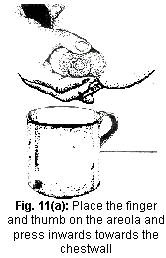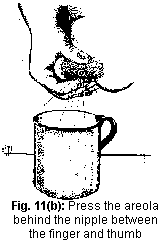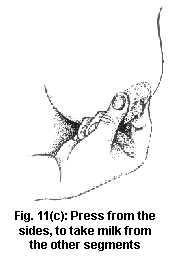Monday, November 28, 2005
Q&A: Breastfeeding and medications.
Your Question:
I have been started on a new medication for a long term medical problem that I have had since I was a child. I fear that the medication may pass in the breastmilk and cause problems for my baby. Do you have any suggestions?
My Answer:
Many medications can pass into the breastmilk. Some in larger quantities than others. Just how much of the medication is secreted into the breastmilk depends on characteristics of the medication itself.
Most medications prescribed for breastfeeding mothers either don't pass into the breastmilk or do so only in quantities much too small to cause any problems.
All medications would carry warnings on any known or hypothetical risks for babies or fetuses if they are taken during lactation or pregnancy. Safety of medications during pregnancy and lactation should be checked by prescribing doctor, especially when they are prescribed for pregnant or lactating women.
I would presume that your doctor whould have done the same. If you are not sure, or have concerns, I would suggest that you see the same doctor and have things clarified. The medication itself must be important enough for it to be prescribed, so it is best to get the clarification early so that you can either start to use it, or get alternative treatment started if safety is a concern.
There are so many different medications available these days that it is not humanly possible for doctors to remember, from the top of their heads, the safety of each one of them. For this reason, most drug (medication) index (guides) have lists of medications and their safety in pregnancy.
Q&A: Breastfeeding during pregnancy?
Your Question:
I am still breastfeeding my first baby who is 1 year 1 month and I think I may be pregnant again! Is it safe for me to continue breastfeeding my first baby?
My Answer:
Yes, it is safe to continue breastfeeding your first child even if you are pregnant with your second. Breastfeeding can be continued safely during pregnancy. Mothers who chose to do so, should be encouraged and provided with assistance as required.
It is important to understand that because you are breastfeeding AND pregnant, your nutritional needs would be more this time around than during your previous pregnancy. This will have to be borne in mind and advise sought from your doctor as to how much increase of nutrition should be aimed at (for the extra required for lactation).
There used to be some concern that breastfeeding during pregnancy would lead to pregnancy complications like, miscarriage, premature delivery or reduced growth of the fetus. This is not true.
Please also note:
- After 6 months of exclusive breastfeeding babies need to be started on complimentary foods. Breastmilk alone is insufficient after 6 months of age. (Complimentary food does not mean other forms of milk!).
- WHO and UNICEF recommend that breastfeeding be continued upto 2 years and beyond.
- If your Obstetrician or doctor recommend that you stop breastfeeding on medical grounds, I would suggest you take that advise. In such cases I would also suggest that you clarify and understand exactly why you are advised to stop breastfeeding as this will be of much benefit.
Wednesday, November 23, 2005
Breastfeeding in the news.
Breastfeeding may reduce a mothers risk of type 2 Diabetes (BBC)
Yes, I thought it was very interesting too. We are all waiting to see more conclusive research on the subject, but this is very encouraging.
Tuesday, October 04, 2005
Hand Expression of breast milk
Hand expression of breast milk
There are many ways of expressing milk from breast. Breast pumps are very commonly used these days. However in my experience, working as a breast feeding counselor, I found most, if not all, pump devices to be very difficult for mothers to use. This was especially so because it caused a lot of discomfort and pain.
The mothers whom I have taught hand expression technique have all told me that it is virtually pain-free and more effective than mechanical pumps. None of them went back to using mechanical devices.
The structure of the breast
I will discuss the structure of the breast that is important from the point of view of hand expression technique. I will be referring to the diagram below during the discussion.

For the sake of discussion I will divide the breast in to 3 parts.
- The first part, the nipple, is the outlet for the milk produced within the breast. At the tip of the nipple are the openings of the milk ducts through which the milk leaves the breast.
- The second part is the areola. This is the darker pigmented (coloured) area of the breast just around the nipple. Beneath this part of the breast are the lactiferous sinuses, which are the collecting areas, where the milk is stored after production. Also very important to note here is that the skin of the areola is relatively pain insensitive (because it has very little pain receptors).
- The third part is the rest of the breast tissue. This is the largest part of the breast. Under the relatively less pigmented skin of this part of the breast are the many glands that produce the breast milk. The glands are supported by fat and connective tissue that make up the bulk of the breast itself. Note in the diagram above the detail of the milk secreting glands (shown enlarged, inset). There is a layer of muscle (very thin) around the milk secreting cells. These muscles contract in response to the hormone Oxytocin to squeeze the glands to push the milk into the lactiferous sinuses via the ducts.
Preparing to hand express breast milk
How to stimulate Oxytocin production
Oxytocin is a hormone produced by the brain that helps “let down” the milk. As described above, it helps contract the muscle layer around the milk producing glands to push the milk into the lactiferous sinuses. Self confidence and comfort for the mother are essential to effective hand expression of milk. Lack of these causes the brain to decrease the production of the essential hormones.
There are many ways in which Oxytocin production can be increased just before starting hand expression.
- Close contact with the baby like cuddling can increase production of Oxytocin.
- Massaging the breast and the nipple increases Oxytocin production. Massaging the breast gently towards the nipple (not squeezing) is very effective. Another techniques described is “combing” the breast gently towards the nipple using the tips of the fingers or a non-sharp comb.
- Back massage over the back of the chest on either side of the spine is also an effective way of increasing Oxytocin production.
- But perhaps the most effective way to increase Oxytocin production is to allow the baby to suckle on the other breast. Many mothers have themselves noted milk flowing from one breast when baby is feeding on the other. This demonstrates the strength of the Oxytocin effect.
How to hand express breast milk
- Sit or stand comfortably with the bowl or cup placed in a position that will help catch the milk.
- Use right hand for left breast and vice versa.
- Place the thumb on the areola above the nipple and the index finger on the areola below the nipple as shown in the diagram (figure 11.a) below. The pulp of the finger and thumb will be in contact with the skin of the areola, not the nipple or the rest of the breast. This is very important.

- Holding the fingers in the position described above, push the fingers into the breast towards the chest wall. When this is done, the areola will be held between the thumb and the index finger (the nipple will no longer be between the fingers).
- Now squeeze the areola between the thumbs and the index finger (Figure 11.b). The lactiferous sinuses underneath the areola will feel like firm “rope” like structures. When squeezed the milk in them will be pushed towards the tip of the nipple. Please note that the areola is relatively pain insensitive and so this should not cause pain. If, however, the nipple or the breast outside the areola was squeezed it would be painful.

- After squeezing, release the areola gently, making sure not to lift the fingers off the skin.
- Leaving the fingers on the areola, allow the breast to return to its normal shape. This will allow the lactiferous sinuses to re-fill with more milk. The reason why the fingers are not lifted off the skin is to minimize “rubbing” action on the nipple and areola.
- Now repeat steps 4 to 7. Note that the first couple of squeezes may not get the milk to flow out. Keep repeating the steps 4 to 7 and milk will begin to flow (maybe even squirt in jets).
- The expressing should be done all around the areola not just with finger above and below nipple. It is important to rotate the fingers all around to ensure all segments of the breast are expressed.

What not to do during hand expression
If you feel pain during hand expression, it is most likely because of incorrect technique. Check and make sure that you are not squeezing the nipple or skin outside of the areola.
Because the nipple is not pressed during hand expression, this method can be used in mothers who are unable to breastfeed because of cracked nipples.
The diagrams are from training manuals produced by BPNI (Breastfeeding Promotion Network of India).

Monday, October 03, 2005
Your question: breastmilk storage
I would like to countinue feeding my baby with breastmilk even when I return to work. I have just learnt how to express milk by hand (thanks to a couple of nurses at IGMH). Can you tell me how long I can store the milk?
My Answer:
Breastmilk can be stored for upto 8 hours at room temperature, 24 hours in a refrigerator and upto a month in a freezer.
Milk that is stored in the refrigerator or the freezer should not be heated as this would destroy the very useful bio-active substances in the milk (protective substances). It should be slowly thawed or brought to room by leaving it at room temperature or by immersing the container in a bowl of luke warm (not hot) water.
I think hand expression of breastmilk, when properly done, is one of the best and more importantly a pain-free way of expressing milk. I would very strongly recommend that every mother learn the proper technique for hand expression of breastmilk.
I will discuss technique in a bit more detail later.
Monday, September 26, 2005
Breastfeeding: it pays to be prepared
This is one part of motherhood that you would want to be well prepared for. Here I have some of my own articles and links to trusted web resources.
My ARTICLES: dr niyaf'sonlineCLINIC
- Starting breast feeds
Perhaps the best time to discuss breastfeeding issues is well before the baby is born. - Breastfeeding: good attachment
A major share of breastfeeding difficulties, especially in first-time mothers, is because of difficulties with attachment of the baby to the breast during a feed. Many of the feeding difficulties and discomforts could be because poor attachment. - Breastfeeding: common misconceptions
Breastfeeding is the most natural and by all accounts the best food that the newborn baby can have. For some breastfeeding comes naturally, while for many others this natural skill needs to be augmented by assistance from experienced mothers and breastfeeding counselors. Some common misconceptions have created problems for breastfeeding mothers, in some leading to failure of feeding.
- Australian Breastfeeding Association
I have already written a bit on this site. Scroll down to read it. - Breast Feeding Network of India
BPNI is an Indian national network of organizations and individuals dedicated to promote mother and child health through protection, promotion and support of breastfeeding. - World Alliance for Breastfeeding Action
WABA is a global network of organizations and individuals who believe breastfeeding is the right of all children and mothers and who dedicate themselves to protect, promote and support this right. - IBFAN
The International Baby-Food Action Network - consists of public interest groups working around the world to reduce infant and young child morbidity and mortality. IBFAN aims to improve the health and well being of babies and young children, their mothers and their families through the protection, promotion and support of breastfeeding and optimal infant feeding practices.
Enjoy
Thursday, September 08, 2005
Information on Australian Breastfeeding Association website.
Starting from very general information to a bit more detailed discussion on specific issues related to feeding is provided.
I especially like the information on how to continue breastfeeding even after returning to work.
It is a lot to read through- but it will be worth the effort and time.
http://www.breastfeeding.asn.au/bfinfo/index.html
Tuesday, August 30, 2005
I was asked to read this:
Here is the link: http://kanbalun.visitaddu.com/breastfeeding.htm
Good on you. Keep it up. I would like to thank the author personally, but the name is not mentioned on the site.
New URL for Dr Niyaf's supportGROUPS
The new URL for the Breastfeeding supportGROUP is http://www.niyaf.com/supportGROUPS/bfgroup.htm
Thursday, June 02, 2005
Welcome to the Breastfeeding Support Group's BLOG
Join in the discussion. I encourage you to use your own name in the discussions.